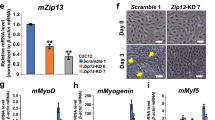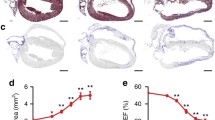Abstract
Plakophilin-2 is a desmosomal protein encoded by PKP2 gene. Desmosomal proteins are usually considered as structural proteins with the main function of maintaining intercellular interactions. Genetic studies revealed that mutations in desmosomal genes could lead to arrhythmogenic right ventricular cardiomyopathy, a heart disease characterized by substitution of cardiomyocytes by adipose and fibrotic tissue predominantly in the right ventricle. Wnt signaling is a signal transduction pathway presumably involved in the development of pathology. The purpose of this study was to investigate Wnt activity in cells with wild-type and mutant PKP2 gene during adipogenic and cardiomyogenic differentiation. We used multipotent mesenchymal stromal cells and iPS cells generated from a patient carrying PKP2 gene mutation. We found that cells with mutant PKP2 exhibited lower transcriptional activity of β-catenin, a key player of Wnt signaling, as well as attenuated expression of its targets SOX2 and SOX9. These findings suggest a signaling role of plakophilin2 by regulating Wnt activity
Similar content being viewed by others
Abbreviations
- ARVC:
-
arrhythmogenic right ventricular cardiomyopathy
- iPSCs:
-
induced pluripotent stem cells
- MMSCs:
-
multipotent mesenchymal stromal cells
- ESCs:
-
embryonic stem cells
- GSK3b:
-
glycogen synthase kinase 3 beta
- PPARg:
-
peroxisome proliferator-activated receptor gamma
References
Awad, M.M., Calkins, H., and Judge, D.P., Mechanisms of disease: molecular genetics of arrhythmogenic right ventricular dysplasia/cardiomyopathy, Nature Clin. Pract. Cardiovasc. Med., 2008, vol. 5, pp. 258–267.
Basso, C., Thiene, G., Corrado, D., Angelini, A., Nava, A., and Valente, M., Arrhythmogenic right ventricular cardiomyopathy, dysplasia, dystrophy or myocarditis?, Circulation, 1996, vol. 94, pp. 983–991.
Caspi, O., Huber, I., Gepstein, A., Arbel, G., Maizels, L., Boulos, M., and Gepstein, L., Modeling of arrhythmogenic right ventricular cardiomyopathy with human induced pluripotent stem cells, Circ. Cardiovasc. Genet., 2013, vol. 6, pp. 557–568.
Chen, S.N., Gurha, P., Lombardi, R., Ruggiero, A., Willerson, J.T., and Marian, A.J., The hippo pathway is activated and is a causal mechanism for adipogenesis in arrhythmogenic cardiomyopathy, Circ. Res., 2014, vol. 114, pp. 454–468.
Corrado, D., Basso, C., Thiene, G., McKenna, W.J., Davies, M.J., Fontaliran, F., Nava, A., Silvestri, F., Blomström-Lundqvist, C., Wlodarska, E.K., Fontaine, G., and Camerini, F., Spectrum of clinicopathologic manifestations of arrhythmogenic right ventricular cardiomyopathy/dysplasia: a multicenter study, J. Am. Coll. Cardiol., 1997, vol. 30, pp. 1512–1520.
Delva, E., Tucker, D.K., and Kowalczyk, A.P., The Desmosome, Cold Spring Harbor Perspectives in Biology. 1. Cold Spring Harbor, 2009. doi: 10.1101/cshperspect.a002543
Franke, W.W., Borrmann, C.M., Grund, C., and Pieperhoff, S., The area composita of adhering junctions connecting heart muscle cells of vertebrates. I. Molecular definition in intercalated disks of cardiomyocytes by immunoelectron microscopy of desmosomal proteins, Eur. J. Cell Biol., 2006, vol. 85, pp. 69–82.
Fuerer, C. and Nusse, R., Lentiviral vectors to probe and manipulate the Wnt signaling pathway, PLoS ONE, 2010, vol. 5, pp. 1–7.
Garcia-gras, E., Lombardi, R., Giocondo, M.J., Willerson, J.T., Schneider, M.D., Khoury, D.S., and Marian, A.J., Suppreßsion of canonical Wnt/ß-catenin signaling by nuclear plakoglobin recapitulates phenotype of arrhythmogenic right ventricular cardiomyopathy, J. Clin. Invest., 2006, vol. 116, pp. 2012–2021.
Gerull, B., Heuser, A., Wichter, T., Paul, M., Basson, C.T., McDermott, D.A., Lerman, B.B., Markowitz, S.M., Ellinor, P.T., MacRae, C.A., Peters, S., Grossmann, K.S., Drenckhahn, J., Michely, B., Sasse-Klaassen, S., Birchmeier, W., Dietz, R., Breithardt, G., Schulze-Bahr, E., and Thierfelder, L., Mutations in the desmosomal protein plakophilin-2 are common in arrhythmogenic right ventricular cardiomyopathy, Nat Genet., 2004, vol. 36, pp. 1162–1164.
Heuberger, J. and Birchmeier, W., Interplay of cadherinmediated cell adhesion and canonical Wnt signaling, Cold Spring Harb. Perspect. Biol., 2010, vol. 2. doi: 10.1101/cshperspect.a002915
Khudiakov, A.A., Kurapeev, D.I., Kostareva, A.A., and Malashicheva, A.B., Comparison of different methods for generation of functional human cardiomyocytes, Cell. Transplant. Tiss. Eng., 2013, vol. 8, 2, pp. 46–54.
Kim, C., Wong, J., Wen, J., Wang, S., Wang, C., Spiering, S., Kan, N.G., Forcales, S., Puri, P.L., Leone, T.C., Marine, J.E., Calkins, H., Kelly, D.P., Judge, D.P., and Chen, H-S.V., Studying arrhythmogenic right ventricular dysplasia with patient-specific IPSCs, Nature, 2013, vol. 494, pp. 105–110.
Leckband, D.E., le Duc, Q., Wang, N., and de Rooij, J., Mechanotransduction at cadherin-mediated adhesions, Curr. Opin. Cell Biol., 2011, vol. 23, pp. 523–530.
Li, J., Swope, D., Raess, N., Cheng, L., Muller, E.J., and Radice, G.L., Cardiac tissue-restricted deletion of plakoglobin results in progressive cardiomyopathy and activation of beta-catenin signaling, Mol. Cell Biol., 2011, vol. 31, pp. 1134–1144.
Lombardi, R. and Marian, A.J., Molecular genetics and pathogenesis of arrhythmogenic right ventricular cardiomyopathy: a disease of cardiac stem cells, Pediatr. Cardiol., 2011, vol. 32, pp. 360–365.
Ma, D., Wei, H., Lu, J., Ho, S., Zhang, G., Sun, X., Oh, Y., Tan, S.H., Ng, M.L., Shim, W., Wong, P., and Liew, R., Generation of patient-specific induced pluripotent stem cell-derived cardiomyocytes as a cellular model of arrhythmogenic right ventricular cardiomyopathy, Eur. Heart J., 2013, vol. 34, pp. 1122–1123.
Mummery, C., Ward-van Oostwaard, D., Doevendans, P., Spijker, R., van den Brink, S., Hassink, R., van der Heyden, M., Opthof, T., Pera, M., de la Riviere, A.B., Passier, R., and Tertoolen, L., Differentiation of human embryonic stem cells to cardiomyocytes: role of coculture with visceral endoderm-like cells, Circulation, 2003, vol. 107, pp. 2733–2740.
Oxford, E.M., Danko, C.G., Fox, P.R., Kornreich, B.G., and Moïse, N.S., Change in ß-catenin localization suggests involvement of the canonical wnt pathway in boxer dogs with arrhythmogenic right ventricular cardiomyopathy, J. Vet. Intern. Med., 2014, vol. 28, pp. 92–101.
Thiene, G., Nava A., Corrado, D., Rossi, L., and Pennelli, N., Right ventricular cardiomyopathy and sudden death in young people, N. Engl. J. Med., 1988, vol. 318, pp. 129–133.
Zhurinsky, J., Shtutman, M., and Ben-Ze’ev, A., Differential mechanisms of LEF/TCF family-dependent transcriptional activation by beta-catenin and plakoglobin, Mol. Cell Biol., 2000, vol. 20, pp. 4238–4252.
Zuk, P.A., Zhu, M., Mizuno, H., Huang, J., Futrell, J.W., Katz, A.J., Benhaim, P., Lorenz, H.P., and Hedrick, M.H., Multilineage cells from human adipose tissue: implications for cell-based therapies, Tis. Eng., 2001, vol. 7, pp. 211–226.
Author information
Authors and Affiliations
Corresponding author
Additional information
Original Russian Text © A.A. Khudiakov, D.A. Kostina, A.A. Kostareva, A.N. Tomilin, A.B. Malashicheva, 2015, published in Tsitologiya, 2015, Vol. 57, No. 12, pp. 868–875.
Rights and permissions
About this article
Cite this article
Khudiakov, A.A., Kostina, D.A., Kostareva, A.A. et al. The effect of plakophilin-2 gene mutations on the activity of canonical WNT signaling. Cell Tiss. Biol. 10, 106–113 (2016). https://doi.org/10.1134/S1990519X16020061
Received:
Published:
Issue Date:
DOI: https://doi.org/10.1134/S1990519X16020061




